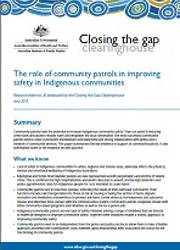The role of community patrols in improving safety in Indigenous communities
Citation
AIHW
The Closing the Gap Clearinghouse (2013) The role of community patrols in improving safety in Indigenous communities, AIHW, Australian Government, accessed 24 April 2024.
APA
The Closing the Gap Clearinghouse. (2013). The role of community patrols in improving safety in Indigenous communities. Canberra: AIHW.
MLA
The Closing the Gap Clearinghouse. The role of community patrols in improving safety in Indigenous communities. AIHW, 2013.
Vancouver
The Closing the Gap Clearinghouse. The role of community patrols in improving safety in Indigenous communities. Canberra: AIHW; 2013.
Harvard
The Closing the Gap Clearinghouse 2013, The role of community patrols in improving safety in Indigenous communities, AIHW, Canberra.
PDF | 238Kb
Community patrols have the potential to increase Indigenous community safety. They can assist in reducing crime rates and alcohol-related harm and empower the local community. The most successful community patrols tend to enjoy community involvement and ownership and strong collaboration with police and a network of community services. This paper summarises the key evidence in support of community patrols. It also summarises some of the evidence on best practice.
Part of Closing the Gap Clearinghouse.
- ISSN: 2201-845X
- ISBN: 978-1-74249-449-4
- Cat. no: IHW 99
- Pages: 20



